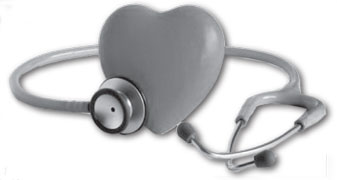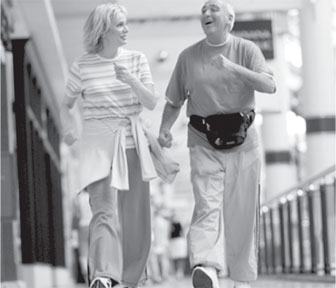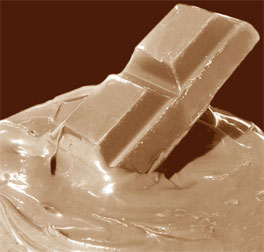|

 For heart health For heart health
Every bit of exercise counts :
People who walk or jog for just a couple of hours each week are at
lower risk of heart disease than those who don’t exercise, suggests a
new study.
And among people already accustomed to getting the blood flowing,
those who go above and beyond on physical activity seem to have the best
heart outcomes, said researchers who analysed past data on exercise and
heart disease risks.
“Exercise is good, more exercise is better,” said David Swain, an
exercise scientist at Old Dominion University in Norfolk, Virginia, who
was not involved in the new research.
 “There’s a continuous improvement in your health and your reducing of
heart disease the more physical activity you do,” he told Reuters
Health. “There’s a continuous improvement in your health and your reducing of
heart disease the more physical activity you do,” he told Reuters
Health.
Still, Swain cautioned, people who are at risk of heart disease and
not used to working out should take it slow, and consult their doctor,
when they’re starting out.
Researchers have known that exercise is good for heart health for
decades. Pounding the pavement on a regular basis helps reduce blood
pressure and improves blood flow in the heart, Swain said.
The authors of the new study, led by Jacob Sattelmair, wanted to test
the benefit of exercise on heart disease in relation to new federal
guidelines to provide a better picture of just how much activity is
necessary for heart protection.
United States guidelines from 2008 recommend 150 minutes of moderate
exercise (such as brisk walking) each week, or 30 minutes five days per
week, as a minimum for health benefit. Twice that, the guidelines say,
adds additional benefit.
The researchers collected data from nine past studies that asked
participants how frequently they exercised, and for how long each time,
and followed them to see who was diagnosed with heart disease over
anywhere from a few years to a couple decades.
Those types of studies do have some limitations, the researchers
noted. For example, they didn’t all collect information on participants’
diets, so it’s hard to know if the heart benefits were from exercise
alone, or due to other health-related factors. Some of the studies took
into account factors like weight and whether participants smoked, while
others did not.
The findings tended to support the new federal guidelines, said
Sattelmair, from the electronic health record company Dossia who led the
research while at the Harvard School of Public Health in Boston.
Taken together, people who exercised according to the minimum
guidelines (equivalent to burning about 550 calories per week through
exercise) had a 14 percent lower risk of heart disease than those who
didn’t exercise at all.
For those who met the higher guideline standard (about 1100 calories
per week), that improved to a 20 percent lower risk, the researchers
reported in Circulation.
People who only got half as much exercise as the minimum guidelines
also had some heart protection compared to non-exercisers, Sattelmair
said. And those who worked out for longer than guidelines recommend
continued to reduce their heart risks - but the added benefit levelled
off with high amounts of activity.
About one in eight adult Americans suffers from heart disease, the
leading killer worldwide.
The study didn’t look at the difference between moderate and more
vigorous exercise, but researchers said that people who work out
intensely get the same or greater benefit from less time than “moderate”
exercisers. While the findings show that more is generally better, “If
you’re doing nothing, you don’t have to start walking an hour a day to
achieve benefit,” Sattelmair said.
Jumping off the couch into a running routine might also be worrisome
for people who are at risk for heart disease, Swain added, and they
should ease into exercise and discuss it with their doctor. Being
overweight and having diabetes or high cholesterol adds to heart risks.
“If you’re totally sedentary...as little as 10 to 15 minutes of brisk
walking a day was associated with a reduction in risk of heart disease,”
Sattelmair told Reuters Health. “Everyone can benefit from movement and
physical activity and exercise.” - Reuters
*******
General workout tips
Be sure any exercise is paced and balanced with rest. Avoid isometric
exercises such as push-ups and sit-ups. Isometric exercises involve
straining muscles against other muscles or an immovable object.
Don’t exercise outdoors when it is too cold, hot, or humid. High
humidity may cause you to tire more quickly; extreme temperatures can
interfere with circulation, make breathing difficult, and cause chest
pain. Better choices are indoor activities such as mall walking. Make
sure you stay hydrated.
It is important to drink water even before you feel thirsty,
especially on hot days. But, be careful not to drink too much water.
Follow your doctor’s guidelines about how much fluid you can have in a
day.
Extremely hot and cold showers or sauna baths should be avoided after
exercise.
These extreme temperatures increase the workload on the heart.Steer
clear of exercise in hilly areas. If you must walk in steep areas, make
sure you slowdown when going uphill to avoid working too hard. Monitor
your heart rate closely.
If your exercise program has been interrupted for a few days (for
example, due to illness, vacation, or bad weather), make sure you ease
back into the routine. Start with a reduced level of activity and
gradually increase it until you are back where you started.
*******
Volunteering to help others could lead to better health
People who volunteer may live longer than those who don’t, as long as
their reasons for volunteering are to help others rather than
themselves, suggests new research published recently.
 This was the first time research has shown volunteers’ motives can
have a significant impact on life span. Volunteers lived longer than
people who didn’t volunteer if they reported altruistic values or a
desire for social connections as the main reasons for wanting to
volunteer, according to the study, published in the APA journal Health
Psychology. People who said they volunteered for their own personal
satisfaction had the same mortality rate four years later as people who
did not volunteer at all, according to the study. This was the first time research has shown volunteers’ motives can
have a significant impact on life span. Volunteers lived longer than
people who didn’t volunteer if they reported altruistic values or a
desire for social connections as the main reasons for wanting to
volunteer, according to the study, published in the APA journal Health
Psychology. People who said they volunteered for their own personal
satisfaction had the same mortality rate four years later as people who
did not volunteer at all, according to the study.
“This could mean that people who volunteer with other people as their
main motivation may be buffered from potential stressors associated with
volunteering, such as time constraints and lack of pay,” said the
study’s lead author, Sara Konrath. Researchers examined data from the
Wisconsin Longitudinal Study, which has followed a random sample of
10,317 high school students from their graduation in 1957 until the
present. The sample is 51.6 percent female, with an average age of 69.16
years in 2008.
In 2004, respondents reported whether they had volunteered within the
past 10 years and how regularly. They reported their reasons for
volunteering (or the reasons they would volunteer, for those who had not
done so) by answering 10 questions.
Some motives were more oriented toward others (e.g., “I feel it is
important to help others,” or “Volunteering is an important activity to
the people I know best”) and some that were more self-oriented (e.g.,
“Volunteering is a good escape from my own troubles,” or “Volunteering
makes me feel better about myself”).
The researchers also considered the respondents’ physical health,
socio-economic status, marital status, health risk factors (i.e.,
smoking, body mass index and alcohol use), mental health and social
support. Much of this information was collected in 1992, 12 years before
the respondents were asked about their volunteering experience.
The researchers then determined how many of the respondents were
still alive in 2008.
Overall, 4.3 percent of 2,384 non-volunteers were deceased four years
later, which was similar to the proportion of deceased volunteers who
reported more self-oriented motives for volunteering (4 percent).
However, only 1.6 percent of those volunteers whose motivations were
more focused on others were dead four years later. This effect remained
significant even when controlling for all the variables.
Additionally, respondents who listed social connection or altruistic
values as their predominant motive were more likely to be alive compared
with non-volunteers.
“It is reasonable for people to volunteer in part because of benefits
to the self; however, our research implies that, ironically, should
these benefits to the self become the main motive for volunteering, they
may not see those benefits,” said the paper’s co-author, Andrea
Fuhrel-Forbis, MA.
- APA
Brain waves control the impact of noise on sleep
 During sleep, our perception of the environment decreases. However
the extent to which the human brain responds to surrounding noises
during sleep remains unclear. In a study published this week in
Proceedings of the National Academy of Sciences (PNAS), researchers used
brain imaging to study responses to sounds during sleep. They show that
brain activity in the face of noise is controlled by specific brain
waves during sleep. In particular, waves called sleep ‘spindles’ prevent
the transmission of sounds to auditory brain regions. Conversely, when
sounds are associated with brain waves called ‘K-complexes’, activation
of auditory areas is larger. Our perception of the environment is
therefore not continuously reduced during sleep, but rather varies
throughout sleep under the influence of particular brain waves. During sleep, our perception of the environment decreases. However
the extent to which the human brain responds to surrounding noises
during sleep remains unclear. In a study published this week in
Proceedings of the National Academy of Sciences (PNAS), researchers used
brain imaging to study responses to sounds during sleep. They show that
brain activity in the face of noise is controlled by specific brain
waves during sleep. In particular, waves called sleep ‘spindles’ prevent
the transmission of sounds to auditory brain regions. Conversely, when
sounds are associated with brain waves called ‘K-complexes’, activation
of auditory areas is larger. Our perception of the environment is
therefore not continuously reduced during sleep, but rather varies
throughout sleep under the influence of particular brain waves.
In this study, the research team shows that brain activity induced by
sounds during sleep closely depends on brain waves that constitute our
sleep. By using Functional Magnetic Resonance Imaging (FMRI) combined
with electroencephalography (EEG), researchers have evidenced that
auditory brain regions remain active in response to sounds during sleep
[see image, left panels], except when sounds occur during brain waves
called sleep ‘spindles’. The study indeed shows that spindles prevent
the transmission of sounds to the auditory cortex [see image, right
panels].
Conversely, sounds can induce the production during sleep of brain
waves called ‘K-complexes’. The results brought by this new study
demonstrate that production of K-complexes by sounds is associated with
a larger activation of auditory brain areas.
While spindles prevent the transmission of sounds, K-complexes
reflect a more important transmission of sounds to the sleeping brain.
The effects of noise on sleep are therefore controlled by specific brain
waves. In particular, the human brain is isolated from the environment
during sleep spindles, which might allow essential sleep functions to
operate such as the consolidation of memory for previously acquired
information. These brain waves thus play a crucial role in sleep quality
and stability in the face of noise. (Sources: Ličge University,
AlphaGalileo Foundation)
No link found between menopause and increased risk of fatal heart
attack
Researchers say data show aging alone, not hormonal impact of
menopause, explains increasing number of deaths as women age.
Contradicting the long-held medical belief that the risk of
cardiovascular death for women spikes sharply after menopause, new
research from Johns Hopkins suggests instead that heart disease
mortality rates in women progress at a constant rate as they age.
The findings, published in BMJ, the British medical journal, could
have implications for how heart health is assessed in pre-menopausal
women, who were previously believed to be at negligible risk of death
from heart attack. “Our data show there is no big shift toward higher
fatal heart attack rates after menopause,” says Dhananjay Vaidya, Ph.D.,
an assistant professor of medicine at the Johns Hopkins University
School of Medicine and the study’s leader. “What we believe is going on
is that the cells of the heart and arteries are aging like every other
tissue in the body, and that is why we see more and more heart attacks
every year as women age. Aging itself is an adequate explanation and the
arrival of menopause with its altered hormonal impact does not seem to
play a role.” Menopause clearly plays a role in other diseases for
women, the researchers found. For example, Vaidya says, the rate of
breast cancer mortality decelerates at menopause, probably because of
hormonal changes.
To reach its conclusions, Vaidya’s team analyzed mortality statistics
for people born in England, Wales and the United States between 1916 and
1945. They followed similar groups of people as they aged and found
that, at the time of menopause in each cohort, there were no increases
in female mortality rates above and beyond the steady curve that is
expected from aging, he says. Vaidya says his team also found that the
number of women who die each year from heart disease increases
exponentially at roughly 8 percent per year. The statistical death rate
curve stays steady throughout life, he says, increasing risk annually in
the same way compound interest increases a bank account balance over
time. Absolute mortality - the actual number of deaths - increases at
all ages with no abrupt change at menopause.
Men
Also surprising, Vaidya says, is what he and his team learned about
men. It has long been known that men are at risk of heart disease
mortality from a much earlier age than women. Vaidya says he found that
the mortality curve for men under the age of 45 actually increases by 30
percent a year, only to slow after that age to roughly 5 percent a year
- similar to the rate throughout the lifetime in women.
The data suggest that something biological may be happening to
younger men that is harming their hearts. “Instead of looking at
menopause, what we should be looking at is what is happening
biologically to men over time,” Vaidya says. “We don’t have an answer.
Good research always creates more questions.” Rapid progress in the
understanding the effects of aging on cells - most notably the concept
of shrinking telomere length - could account for some of the gender
differences, Vaidya suggests.
Telomeres are found at the end of each chromosome in the body and act
as shields that protect important genes from assault. Telomeres shrink
every time they are copied, which occurs every time cells divide.
As telomeres get shorter, there is the chance that the genes at the
end of the chromosome will get damaged, and if they are, they will not
recover, leading to the damaging effects of aging. such may be the case
in heart disease mortality.
Previous studies have shown that telomere lengths are similar in male
and female babies, but become significantly shorter in young adult men
as compared to young adult women, which could account for the finding
that men have increased risk of cardiovascular mortality at younger
ages. At later ages, telomeres shorten at similar rates in men and
women, which could account for their similar heart disease mortality
rate increases during older ages.
- MNT
Chocolate and cocoa polyphenols vindicated in the war against heart
disease
Researchers from the University of Cambridge in Englandhave published
evidence to demonstrate the consumption of chocolate is associated with
improved heart and vascular health.
 Writing in the BMJ (British Medical Journal), Dr. Oscar Franco and
his team determined several factors including diet,exercise, body weight
control and lifestyle changes could help reduce the risk of heart
disease, a condition expected to claim the lives of nearly 24 million
people worldwide by the year 2030. The study authors found that the
antioxidant and anti-inflammatory properties of cocoa from chocolate
consumption could reduce heart disease risk by one-third and could also
reduce the risk of sudden death from a heart attack and stroke
incidence. Writing in the BMJ (British Medical Journal), Dr. Oscar Franco and
his team determined several factors including diet,exercise, body weight
control and lifestyle changes could help reduce the risk of heart
disease, a condition expected to claim the lives of nearly 24 million
people worldwide by the year 2030. The study authors found that the
antioxidant and anti-inflammatory properties of cocoa from chocolate
consumption could reduce heart disease risk by one-third and could also
reduce the risk of sudden death from a heart attack and stroke
incidence.
The study included an analysis of seven detailed research bodies that
included more than 114,000 participants. All studies independently
pointed to the conclusion that different levels of chocolate consumption
were associated with a substantial reduction in the risk of
cardio-metabolic disorders. Researchers found that the flavonoids passed
to chocolate from the cocoa bean have a positive impact on health and
were found to regulate insulin sensitivity and maintain blood pressure
in the normal range.
Researchers ranked chocolate consumption among participants in the
seven studies from highest to lowest to determine the effect of the
cocoa flavanols on human health risk factors. Five of the seven studies
showed that eating the highest amount of chocolate significantly reduced
the number of cardiac events. In particular they found those who ate the
most chocolate had a 37% lower risk of having a cardiovascular incident
compared to those who ate the least.
When assessing other risk factors, the study authors found that the
highest chocolate consumers had a 29% lower incidence of stroke compared
to the lowest chocolate eaters. Interestingly the researchers found that
high levels of chocolate consumption specifically lowered the risk of a
cardiac or stroke event but did not impact heart failure, another very
serious form of heart disease and death. The studies examined did not
differentiate between milk and dark chocolate, and included chocolate
desserts, biscuits, chocolate bars and drinks. Prior research has
indicated maximum benefit from eating dark, bitter chocolate with a high
cocoa content.
Caution
The authors did provide a word of caution regarding excess
consumption of chocolate particularly because commercially available
chocolate is very caloric and eating too much of it could in itself lead
to weight gain, risk of diabetes and heart disease. They concluded,
“Based on observational evidence, levels of chocolate consumption seem
to be associated with a substantial reduction in the risk of
cardio-metabolic disorders.”
Individuals looking to take advantage of the health benefits of
chocolate may want to use a cocoa bean extract supplement (25 to 50 mg
per day) to reap the cardiovascular and stroke risk reduction benefits.
- NaturalNews
|

